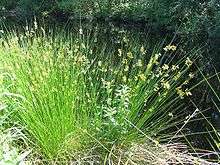Juncaceae
Juncaceae is a family of flowering plants, commonly known as the rush family. It consists of 8 genera and about 464 known species[2] of slow-growing, rhizomatous, herbaceous monocotyledonous plants that may superficially resemble grasses and sedges. They often grow on infertile soils in a wide range of moisture conditions. The best-known and largest genus is Juncus. Most of the Juncus species grow exclusively in wetland habitats. A few rushes, such as Juncus bufonius are annuals, but most are perennials.
| Rush family | |
|---|---|
 | |
| Juncus effusus | |
| Scientific classification | |
| Kingdom: | Plantae |
| Clade: | Tracheophytes |
| Clade: | Angiosperms |
| Clade: | Monocots |
| Clade: | Commelinids |
| Order: | Poales |
| Family: | Juncaceae Juss.[1] |
| Type genus | |
| Juncus | |
| Genera | |
| Synonyms | |
| |
Description
The leaves are evergreen and well-developed in a basal aggregation on an erect stem. They are alternate and tristichous (i.e., with three rows of leaves up the stem, each row of leaves arising one-third of the way around the stem from the previous leaf). Only in the genus Distichia are the leaves distichous. The rushes of the genus Juncus have flat, hairless leaves or cylindrical leaves. The leaves of the wood-rushes of the genus Luzula are always flat and bear long white hairs.
The plants are hermaphroditic or, rarely, dioecious. The small flowers are arranged in inflorescences of loose cymes, but also in rather dense heads or corymbs at the top of the stem or at its side. This family typically has reduced perianth segments called tepals. These are usually arranged in two whorls, each containing three thin, papery tepals. They are not bright or flashy in appearance, and their color can vary from greenish to whitish, brown, purple, black, or hyaline. The three stigmas are in the center of the flowers. As is characteristic of monocots, all of the flower parts appear in multiples of three.
The fruit is usually a nonfleshy, three-sectioned dehiscent capsule containing many seeds.
Domestic uses
The dried pith of plants of this family were used to make a type of candle known as a rushlight.
The soft rush (Juncus effusus) is called igusa in Japanese and is used to weave the soft surface cover of tatami mats.
In medieval Europe, loose fresh rushes would be strewn on earthen floors in dwellings for cleanliness and insulation. Particularly favored for such a purpose was Acorus calamus (sweet flag), but despite its alternate vernacular name "sweet rush", it is a plant from a different monocot order, Acorales.[3]
References
- Angiosperm Phylogeny Group (2009). "An update of the Angiosperm Phylogeny Group classification for the orders and families of flowering plants: APG III". Botanical Journal of the Linnean Society. 161 (2): 105–121. doi:10.1111/j.1095-8339.2009.00996.x. Archived from the original (PDF) on 2017-05-25. Retrieved 2013-06-26.
- Christenhusz, M. J. M.; Byng, J. W. (2016). "The number of known plants species in the world and its annual increase". Phytotaxa. Magnolia Press. 261 (3): 201–217. doi:10.11646/phytotaxa.261.3.1.
- Burton, Alfred. Rush-bearing: An Account of the Old Custom of Strewing Rushes: Carrying Rushes to Church; The Rush-Cart; Garlands in Churches; Morris-Dancers; The Wakes; The Rush. Manchester: Brook & Chrystal, 1891; pp. 1-12
External links
| Wikimedia Commons has media related to Juncaceae. |
- Information and pictures

- . Encyclopædia Britannica (11th ed.). 1911.